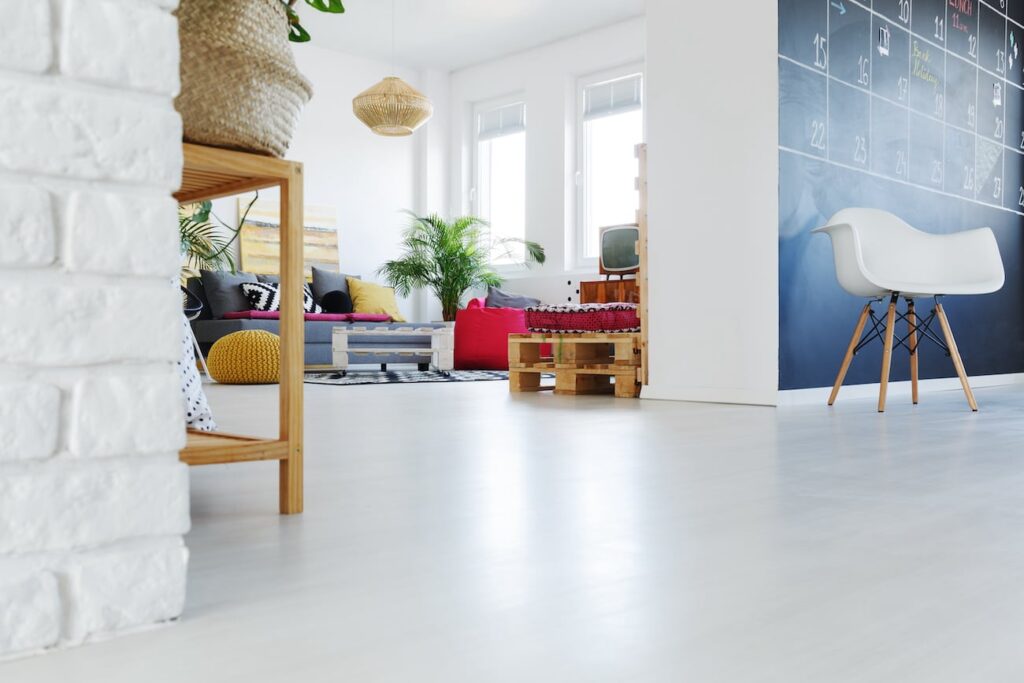Once you decide to purchase a vinyl flooring for your home, either for your new built home or for your home improvement, you should consider the vinyl flooring environmental impact if you concern more about the environment.
In fact, vinyl flooring is increasing its popularity from times to times, making the manufacturers keep producing such flooring type.
More or less, the process of manufacturing, installation and the usage itself may endanger the environment in some particular aspects.
For example, the manufacturing process includes the use of chemicals. Certain types of vinyl flooring use adhesive installation technique carries the toxic within the installation process.
And while vinyl is mostly constructed from the unrecyclable materials may stay in the landfill for decades without being able to breakdown.
In this case, there are some serious environmental concerns about the vinyl flooring surface materials.
In fact, vinyl flooring is potentially causing danger to both the homeowners and the environment.
In this regards, we come with the review of vinyl flooring environmental impact to let you to understand deeply about it.
Hence, we have more to present in this article. It includes the definition of vinyl flooring manufacture, dioxins and vinyl flooring, vinyl flooring rebuttal, worker safety, chlorine storage, the use of materials and energy in the vinyl production, the environmental effect after the installation and the final cycle of vinyl flooring’s life.
Simple let’s go to the review sections below to check them all out.
Vinyl Flooring Manufacture
Vinyl flooring manufacture is defined as vinyl flooring materials containing Poly Vinyl Chloride (PVC).
This is the technical name for the materials that are used to construct the vinyl flooring.
In fact, there are about 14 billion pounds of vinyl flooring which are produced and sold in the United States every year.
This means that vinyl flooring is widely popular and used on the globe. However, understanding the impact on environment is crucial.
Read Also: How to Select Flooring – 7 Best Candidates to Choose
Dioxins and Vinyl Flooring
Have you ever heard the dioxins?
If you have been familiar with kinds of flooring especially the vinyl flooring, it must be common to know what dioxins actually are.
Well, dioxins are the carcinogenic bioaccumulative toxins that exist in the environment for a long time.
These toxics are the dangerous chemicals resulted from the manufacturing process of Chloride in PVC.
They are the substances that carry a health risk to anyone who are much exposed to them.
Often, the toxins can remain long enough, traveled hundreds miles away and cause a danger across the territory.
Sadly, they can also infect the creatures in the environment in terms of food chain consumed by the animals around.
If one of these animals are also the sources of human food, then it is not neglected that human is also infected by the toxins.
There are still more vinyl flooring environmental impact caused by the toxins resulted from the vinyl flooring manufacturing process. Those toxins include ethylene dichloride and vinyl chloride.
These substances can cause a serious harm to the environment and the people living around the areas where the manufacturing occurs.
In addition to the substances used in vinyl flooring manufacture, phthalates is also included to achieve the desired vinyl flooring characteristics.
Phthalates are mixed with the other substances of vinyl flooring materials during the PVC production.
Believe it or not, phthalates are just the other toxics linked to the health problems especially for reproductive and respiratory system.
People who are much exposed to this substance will potentially suffer from reproductive and respiratory health problems.
In short, the chemicals used in manufacturing the vinyl flooring materials are not really good for either environment or human as well.
Vinyl Manufacturers’ Denial
Due to the lots of information supporting the fact that environment is in danger because of the vinyl production, the vinyl manufacturers appear to give their statements dealing with these issues. They have their own perspective to share with the people.
In the manufacturing process, dioxins which is the most dangerous toxins, is also created along with the incinerated organic materials.
Basically, dioxins are produced as a result of natural occurrences which are forest fires and volcanic eruptions.
Some studies were conducted to evaluate the impact of dioxins in the environment.
Truly, the dioxins level dropped over the last 40 years though the drama about the use of dioxins in vinyl flooring production always increases.
Safety for The Workers
In this vinyl flooring environmental impact review, safety for the worker is also taken into a big concern.
In 1970s, doctors found that the workers of vinyl flooring manufacturers were suffering from an uncommon high-levels of cancer with specific types.
These workers were employed and too much exposed to the sub-element in PVC manufacturing.
These studies were conducted basically to improve the safety for the workers involved in vinyl manufacturing process.
Nowadays, PVC is processed through a closed-loop system at which the workers are placed at the minimum risk of being exposed to the substances.
As a result, there is no more reported cases of certain types of cancer caused by substance.
Chlorine Storage
In fact, the chlorine used in producing PVC gives not only an environmental threat but also a bio-hazard that is potentially exploited by the terrorist.
Due to the high volatile and toxic, the warehouses where the chlorine is stored are the potential target of the terrorist to attack.
This is based on the identification conducted by the United States air force. The terrorist seems to attack the environment by spreading the poison for miles.
The Use Of Materials and Energy in Vinyl Production
In manufacturing the vinyl flooring, petroleum which is a nonrenewable resource is the main ingredient used.
However, the amount of petroleum used in vinyl manufacture is less than that used in most plastics.
Environmental Impact After Installation
Due to the materials used in vinyl manufacture, vinyl will emit many different levels of VOC (Volatile Organic Chemicals) into the air for a certain period. This usually occur after the first installation process.
Volatile Organic Chemicals are the toxics substances which are much harmful in contributing the respiratory problems. In this case, the air quality will not be good for the environment.
The amount of VOC releasing will depend on the flooring materials quality as well as the amount of time for installation.
To minimize the risk of health problem, make sure you purchase the flooring product with the best quality and the space where you install the flooring provides good ventilation.
Adhesives also play the role in presenting the vinyl flooring environmental impact.
It includes asbestos as well as other chemicals that lead to the VOC emission just after the installation. Thanks to the modern adhesive mixes that have solve such problems.
In addition to minimize the risk of environmental impact, make sure you read all the labels and installation guidance to ensure that you don’t expose yourself to the health risks.
Durability can also contribute to the environmental impact.
In this case, vinyl flooring can last for 10 to 20 years, longer than the most carpet and other flooring with soft surface solutions.
When it comes to remove, dispose of and replace the floors, they can stay in the landfills for decades at a time.
In addition, vinyl flooring cannot be refinished, meaning that you must remove the damaged planks and replace them with the new ones.
Differently, vinyl tile is easier to process. An individual tile can even be removed and replaced effortlessly.
On the other hand, sheet vinyl can be the one way solution to repair the floor by removing a section of it.
When the whole surface of the floor has worn down the flooring materials, the floor will be useless and it needs to be replaced.
Fire hazards can also be the source of problems for vinyl flooring.
Once the vinyl is burned, the noxious fumes will be emitted and make the air full of harmful toxins including the dioxins.
No matter the large of small the scale of fire breaks out, the vinyl flooring will be burnt.
Read Also: Moduleo Vinyl Plank Review for Your Flooring Consideration
The Final Cycle of Vinyl’s Life
There are two things dealing with the final cycle of vinyl flooring. Those are waste and recyclability.
When it comes to disposing the flooring materials while they are not biodegradable, they will just sit in the landfill for so many years.
In this case, the vinyl materials can be reused as liners for the garbage dumps. This is how the liners contain the waste materials that can spill out outside the edges.
Is there any possible for recycling the vinyl flooring materials?
In fact, the vinyl flooring materials are not biodegradable as well as unrecyclable. This is due to the fact that vinyl has different chemical compositions which are also incompatible.
The adhesive, in fact, is one of the causes why the vinyl cannot be recycled especially when an old floor tile or plank are removed from the underlayment layers.
These layers are invisible to the spills, meaning that they need no chemical consistency that the top layers should have.





